The smartphone market is more varied than ever in 2025. It can be difficult to choose the best phone because hundreds of models are released each year. Do you prefer high-end or low-cost phones? Does battery life matter more than camera quality? What about privacy and software support?
This guide will assist you in sorting through the marketing clutter and locating a phone that truly suits your needs, regardless of whether you’re a student, business user, gamer, or casual browsing.
First, establish your user profile.
Understanding your needs is the first step, not looking through gadgets. Consider this:
How many times a day do you use your phone?
Do you edit movies or play games?
Is the camera the most important thing?
Do you want software support that lasts?
What is your highest spending limit?
You may eliminate extraneous features and concentrate on what really matters once you know what matters to you.
Step 2: Select an operating system (iOS vs. Android).
The most important choice: Android or Apple?
Apple iPhone (iOS):
Secure, seamless, and closely linked with other Apple products
Extended software support (five to six years)
Reduced personalization
High-end prices
Android (including OnePlus, Google, Samsung, and others):
Greater diversity in terms of gadgets, costs, and designs
Very adaptable
Greater freedom for apps and an open file system
Brand-specific software support varies.
If you are already using Apple products (MacBook, Apple Watch, AirPods), go with iOS.
If you want flexibility, affordable options, or cutting-edge capabilities like split-screen and expandable storage, go with Android.
Step 3: Establish a Reasonable Budget
Smartphones are now available across a wide spectrum of prices. This is a breakdown for 2025:
Less than $300: Excellent for occasional users. Large batteries, simple cameras, and respectable screens are to be expected.
The Samsung A14, Nokia G400, and Moto G Power are the best choices.
The mid-range, or $300 to $600, is a sweet spot with great value. Competitive cameras, excellent displays, and seamless operation.
Top choices: OnePlus Nord 3, Samsung Galaxy A55, and Google Pixel 7a.
$600–$1000 (Upper-mid to Flagship): High-end construction, quick CPUs, and cutting-edge cameras.
The best choices are the Pixel 8 Pro, Samsung S24, and iPhone 14.
Ultra Flagship/Foldables, which cost $1000+, offer superior performance, state-of-the-art features, and ongoing updates.
The Xiaomi 14 Ultra, Galaxy Z Fold 6, and iPhone 15 Pro Max are the top choices.
Step 4: Camera: What Is Actually Necessary?
Camera specifications can be deceptive. Better images with more megapixels.
More important is:
Apple and Google are superior in terms of sensor size and software.
For crisper images in low light, use optical image stabilization (OIS).
Telephoto and ultra-wide lenses: For artistic adaptability.
Video features: Check for frame rates, stabilization, and support for 4K and 8K.
Think about phones like these if you enjoy mobile photography or are a content creator:
The renowned computational photography of the Google Pixel 8 Pro
The multipurpose camera array of the Samsung Galaxy S24 Ultra
Leading-edge video and cinematic settings on the iPhone 15 Pro
Step 5: Charging Speed and Battery Life
By 2025, the majority of mid-to high-end Android phones will come with 5000 mAh batteries as standard. iPhones often have better optimization and smaller batteries.
Important advice:
Aim for a minimum of 6–7 hours of screen time (SOT).
Fast charging: ideally 25W or more, while some Android phones can reach 100W or more.
A pleasant perk, particularly for iPhone owners who have MagSafe accessories, is wireless charging.
If you’re constantly on the go, stay away from phones with small batteries or slow charging speeds.
Step 6: Rate of Display and Refresh
Your primary means of communication should be through screens; don’t accept anything less.
Seek out:
OLED or AMOLED is superior to LCD in terms of power efficiency and contrast. For smoother scrolling, use a refresh rate of at least 90 Hz (120 Hz is now typical).
For optimal outdoor visibility, brightness must be at least 800 nits.
Phones with dual speakers, high touch response speeds, and HDR10+ support are ideal for gamers and media lovers.
Step 7: Software Support and Longevity
This frequently disregarded element is quite important.
With more than five years of significant model revisions, Apple is in the lead. On Android:
Google (Pixel) provides OS and security upgrades for seven years.
Samsung promises five years of security and four years of major updates.
Before making a purchase, examine the official policy of other brands since they can lag.
Invest in a phone with long-lasting hardware and software.
Step 8: Additional Features That Could Be Important
Check for an IP67 or IP68 grade for water resistance.
Support for 5G is standard on phones in the mid-range and higher.
Some Android devices still have expandable storage.
Travelers can be future-proof with eSIM compatibility.
For simplicity and security, use a fingerprint reader or face unlock.
Although they continue to be a premium niche, foldables (like the Galaxy Z Flip 6) are becoming more robust.
